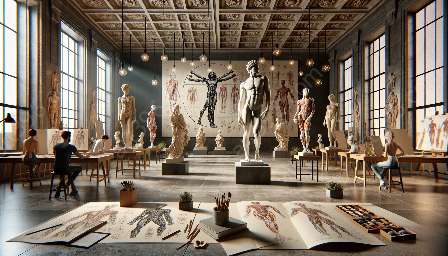Artistic compositions, particularly those involving the human form, often seek to merge the scientific understanding of anatomy with the principles of design, resulting in compelling and lifelike representations. This article explores the interconnected relationship between anatomy and the principles of design, specifically in the context of drawing the human form and the study of artistic anatomy.
Understanding the Human Form:
The human body, with its structural complexity and organic forms, is a central subject in many forms of visual art. Artists who aim to accurately depict the human form typically rely on a foundational understanding of anatomy, which involves studying the structure and function of the body's various systems, bones, muscles, and proportions. This knowledge serves as a fundamental tool for artists as they seek to create realistic and expressive representations of the human figure.
Intersections with Principles of Design:
The principles of design, encompassing concepts such as balance, proportion, rhythm, emphasis, and unity, play a crucial role in composing visually appealing and harmonious artworks. When applied to the representation of the human form, these principles guide artists in creating compositions that are not only anatomically accurate but also aesthetically engaging. For instance, the principle of balance can influence an artist’s decision in positioning the human figure within the composition, ensuring a visually pleasing distribution of visual and physical weight.
Furthermore, understanding principles such as proportion and rhythm allows artists to depict the human form in a manner that captures the natural flow and movement of the body while maintaining a sense of visual equilibrium. Emphasis, as another design principle, assists artists in directing the viewer’s attention to specific aspects of the human anatomy, creating focal points that convey narrative or emotional significance.
Artistic Anatomy and Application:
Artistic anatomy serves as the bridge between the scientific study of the body and its application in the visual arts. Artists who delve into artistic anatomy not only acquire a profound understanding of the structures and functions of the human body but also gain insights into how to effectively apply this knowledge to their artistic creations. By studying how muscles and bones interact, artists can accurately represent the human form in various poses and movements, allowing them to communicate strength, grace, or vulnerability with precision.
Conclusion:
Overall, the intersections between anatomy and the principles of design in artistic compositions are pivotal in elevating the portrayal of the human form in visual art. By integrating anatomical knowledge with design principles, artists can produce evocative, visually balanced, and anatomically accurate compositions that resonate with viewers on both aesthetic and intellectual levels. Understanding this relationship allows artists to create works that not only showcase technical skill but also convey the beauty and complexity of the human body.

